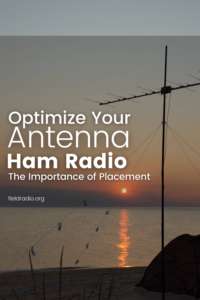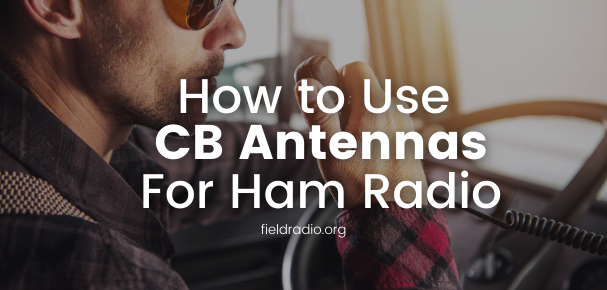
The placement of your Ham Radio Antenna is very important in amateur radio, you do not want to be wasting any of your ham radio equipment’s full potential and ham radio antennas are no exception.
Placement is one of the most important decisions you will make. The most basic thing to note is that your ham radio antenna system becomes more effective the higher they go on a tower or up some other structure.
You can get just as good results from ham radios antennas that are not as high, but ham radio antennas with the best placement will almost always outperform ham radios antennas with bad placements. This is why ham radio antenna placement becomes so important.
How high does a ham radio antenna need to be?
The height of your Antenna is important for ham radio contact, so if your ham radio antenna is low to the ground then it will have less ham radio signal.
The best height for a ham radio antenna is between 10ft – 15ft off the ground.
The ham radio antenna should be higher the further away you are because ham radio signals follow a straight line.
A ham radio antenna needs to be high enough to send ham radio waves across large distances without ham radio obstacles getting in the way.
Is there any benefit to having more than one ham radio antenna?
If ham radio frequencies are important to you, then ham radio antennas need to be placed in different areas for best ham radio contact.
There is ham radio wiring that can allow two antennas to be connected so ham radio signals go through the wire and into your ham radio receiver.
If you have two ham radio antennas on two separate supports but are mounted at the same height, then ham radio signals will not be blocked by ham radio obstacles along the ham radio path.
What is the best direction for a ham radio antenna?
You will want to make sure that your ham radio antenna is pointing in a clear direction. This means it should not be blocked by trees, buildings, or even other ham radios ham antennas.
Position your ham radio antennas symmetrically on each side of your ham radio station. This will ensure that both transmitter and receiver are at equal strength.
How close can ham radio antennas be?
Antennas should at least be one ham radio antenna length apart. This ham radio rule will ensure that you are not interfering with other ham radios ham antennas. Ensuring your Antennas are not too close together will also ham radio prevent you from experiencing noise.
How close can a ham radio antenna be to power lines?
You want to make sure that your ham radio antenna is away from power lines for safety reasons. You should not place your ham radio antenna underneath power lines or on top of power lines.
What is a ground plane used for?
The ham radio ground plane is a metal plate that ham radios antennas are placed on top of, and they can serve as an alternative to ham radio masts.
By placing ham radio antennas on a ham radio ground plane you will be able to improve your ham signal reception and transmission.
What is Antenna polarization?
Antenna polarization refers to the ham radio antenna orientation (or how the ham radio antennas are positioned). There are two types of polarization: vertical and horizontal.
Vertical polarization is when your ham radio antenna points straight up, while horizontal polarization ham radios antennas point along the horizon line of ham radio Earth.
Should you install an antenna in your attic or roof?
Yes. You should install ham radio antennas in your attic or on your roof because these are the best ham radio antenna locations for ham signals to travel through.
The ham radio antennas should go through windows, vents, or any other openings so that ham radio signals can pass easily through them.
How to test if ham radio antennas are working
Before you go to another ham radio location, you should test your ham radio antennas at home first to ensure that they work and that you have not crossed any wires.
At your ham radio station, turn on both your ham transmitter and ham receiver and place the rubber duckie antenna of the ham receiver close to ham radio antennas.
If ham radio repeater signals are heard on ham radios ham receivers, then the antennas are set up correctly. If no ham radio signal is heard, then you have placed ham radio antennas incorrectly and should check your setup.
Antenna Frequency Considerations
Antennas have a ham radio frequency range in which they can provide optimal propagation. The optimal frequency for your Antenna depends on its type.
The best frequency for basic ham radio is around 14 Mhz. To make sure you can transmit at this frequency, you should check the standard frequency ham bands. Search for your country to get all ham band information (including ham radio standard frequency ham bands).
Conclusion
Keep in mind that there is no perfect answer and each installation will be unique with its challenges. Adding multiple Antennas will increase the complexity, but will also improve your ham radio reception.
You should install ham radio antennas in a way to make them easily accessible for future maintenance and replacement of parts if necessary.
The frequencies and distance of the ham radio antennas are important considerations. If you have high ham radio frequencies, then the Antenna should be installed on a higher location.
If your antennas are close to each other, make sure that they do not interfere with each other ham radios signals. The distance of an antenna from power lines is also very important for safety reasons. Make sure to keep your Antennas away from power lines.
If you do not know where to start, then the best thing to do is hire a ham radio professional who can help with your installation and setup of ham antennas.
You should test your Antennas at home before setting up your station in other locations because it will save you time and money if something does not work as planned.
The most important thing is that you keep an open mind about all potential solutions and don’t get discouraged if it takes some time to figure out the best placement of your Antenna.

I have been passionate about the world of communications in its various forms for most of my life. Ever since I first found an old ham radio stashed away in my uncle’s attic, I have had a fascination with this classic technology.
Having the ability to communicate with people without the need to rely on telephone lines or networks is an empowering feeling which I believe everyone should have at least a basic knowledge of. Becuase who knows when you might need it?
I setup fieldradio.org with this passion in mind, to help inform people about the amazing possibilities of amateur radio and I’m on a quest to help educate as many budding operators as possible.
I hope you enjoy our content. Come and say hi, via our contact form



